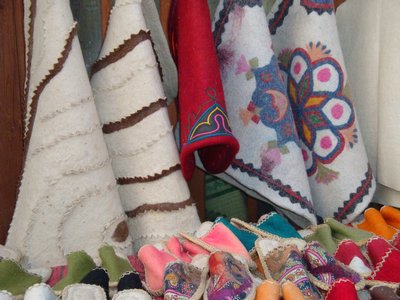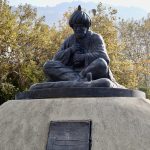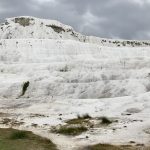Today’s Tuesday so it’s market day in Tire. I’m in need of some of the excellent felt slippers with which I aways associate the town, so now seems like the perfect opportunity to try out the train service linking the town to İzmir. In England I would probably need to have gone online six months ahead of time to check all the options and make a reservation or face a punitive price with the added risk of having to stand up all the way. Here I just hand over five lira, hop in the train (actually something called a rayotobüs – a rail-bus) and away we go.
An hour and a half later I’m in Tire strolling up the high street to Tahtakale, the old part of town, whose streets fill up with stalls and enthusiastic shoppers even on winter Tuesdays. I’m walking along in some trepidation, not quite sure what to expect. Last time I came here a few years ago some streets were being dug up and relaid, and an old hamam was being enthusiastically restored. I’m half-expecting to find everything tidied up and prettified, so it’s quite a relief to discover the streets just as delightfully ramshackle as in the past.
This is a fascinating place, one of those curious inland towns that most people have never heard of and yet which is full of crumbling old hans, hamams and mosques. It doesn’t take me long to find the hamam that was under restoration on the last visit. Work has now been completed and working in there I find Ethem Tıpırdık seated at an extraordinary loom equipped with 24 shuttles and 13 pedals. On this he’s carrying out something called beledi dokunma (weaving) which apparently dates back to the 16th century. “Fifty years ago there were still sixty looms going,” he tells me. “Now there’s just me. It’s not economic. In a day I can only weave three metres. A machine can do hundreds of metres.” He hangs on in there thanks to support from the local Belediye.
I look at what he’s working on. Across the loom there’s a glorious piece of silk weaving in red and silver. It would make fantastic curtains or cushion covers but he plans to cut it up for ties or a waistcoat. A terrible waste, I think, but then with few tourists coming here presumably he has to cater for local tastes.
Ethem Bey is a mine of local information. I already know about the felt-makers of Tire who turn out a successful mix of workaday felts and arty lines in shawls and bags but he reminds me that there are still saddle-makers and men turning out muzzles for camels too.
“But no one keeps camels any more.”
“Oh yes they do,” he says and reminds me of the wrestling camels of the Aegean.
There’s also someone, he says, who turns out ornamental horseshoes. Hmm. I think it’s time to be moving on but the point has been forcefully made: that Tire is not just its old monuments but its historic handicrafts too.
One other thing Ethem Bey mentioned is something I come back to later in the day after I take a taxi up into the hills above Tire to visit the restaurants at Kaplan with their beautiful views. We stop off en route at the Yakupluoğlu mosque complex at the point where Tire fades out into the countryside. It’s a wonderful place that reminds me of an isolated medieval monastery complete with what looks like a belltower but isn’t. Comprehensively restored, it is, sadly, locked like every other mosque in Tire which could I suppose be protection against market-day visitors but seems a little unnecessary out here. The complex dates back to the Beylik era, that strange period in medieval history that was sandwiched between the Selçuk and Ottoman periods when Anatolia splintered into all sorts of mini fiefdoms, most of them barely remembered except by historians.
The view from the Kaplan Restaurant is to die for, and I’m sure the food would be too except that this is winter and I’ve arrived at 3.30pm which is hardly a mealtime and when I’m conscious of the rapidly fading light. As we drive back into Tire the taxi driver picks up where Ethem Bey left off. “There’s a mosque here built right on top of a church,” he says and I remember that Ethem had said that it was near the town’s new boutique hotel at Derekahve.
I’m not quite sure what to expect. It is, after all, quite common to find a mosque built on a site where there was once a church in the past (think, for example, of Fatih Cami in Istanbul, built on the site of the Church of the Holy Apostles). Usually there’s no trace of the previous building or just odd reminders in the form of old columns, capitals or other reused fragments of masonry, so I’m astonished to find a functioning mosque built literally on top of a chapel building, both of them sited to take advantage of an ayazma, or holy spring, in a valley that has now been beautifully landscaped. “We used to get on so well,” said the taxi driver, then, after a pause: “Not like now.”
Moving hastily on. I pause to inspect the new hotel housed in a pair of old Ottoman houses and very handy for the market. “We get very busy midweek with businessmen,” warns the receptionist.
Suddenly time is running out on me. I’ve already missed the direct rayotobüs back to İzmir, but if I hurry there will just be time to sample Tire köfte before catching the connecting train. Actually, the köfte is unexceptional, especially after the naughtily delightful Manisa kebab encountered a few days earlier, but I make it back to the station just as darkness settles over Tire. One stop down the line we must get out of the train and cross the platform for the connection. I expect a long wait in the cold but instead the train is there and waiting for us with stereotypical Germanic efficiency. We arrive back in İzmir at the time stated on the timetable. Clearly I need to start factoring trains back into my schedules.
Written: 22 November 2011



